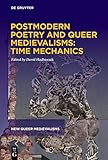Postmodern Poetry and Queer Medievalisms: Time Mechanics / ed. by David Hadbawnik.
Material type: TextSeries: New Queer Medievalisms ; 2Publisher: Kalamazoo, MI : Medieval Institute Publications, [2022]Copyright date: ©2022Description: 1 online resource (VII, 211 p.)Content type:
TextSeries: New Queer Medievalisms ; 2Publisher: Kalamazoo, MI : Medieval Institute Publications, [2022]Copyright date: ©2022Description: 1 online resource (VII, 211 p.)Content type: - 9781501518829
- 9781501511233
- 9781501511189
- 811/.609358 23/eng/20220610
- PS326 .P67 2022
- online - DeGruyter
- Issued also in print.
| Item type | Current library | Call number | URL | Status | Notes | Barcode | |
|---|---|---|---|---|---|---|---|
 eBook
eBook
|
Biblioteca "Angelicum" Pont. Univ. S.Tommaso d'Aquino Nuvola online | online - DeGruyter (Browse shelf(Opens below)) | Online access | Not for loan (Accesso limitato) | Accesso per gli utenti autorizzati / Access for authorized users | (dgr)9781501511189 |
Frontmatter -- Table of Contents -- Acknowledgments -- Introduction: The Opening of the Field -- “A Real Fictional Depth”: Transtexuality & Transformation in Robert Glück’s Margery Kempe -- A Basket of Fire and the Laughter of God: Anne Sexton’s Queer Theopoetics -- Feeld Notes: Jos Charles’s Chaucerian “anteseedynts” -- The Time Mechanic and the Theater: Translation, Performativity, and Performance in the Old English of Karen Coonrod’s Judith, W.H. Auden, and Thomas Meyer -- Translation for the End Times: Peter O’Leary’s The Sampo -- The Harlot and the Gygelot: Translation, Intertextuality, and Theft in Medbh McGuckian’s “The Good Wife Taught her Daughter” -- Queer Time, Queer Forms: Noir Medievalism and Patience Agbabi’s Telling Tales -- Speak Like a Child: Caroline Bergvall’s Medievalist Trilogy -- Index
restricted access online access with authorization star
http://purl.org/coar/access_right/c_16ec
This volume builds on recent scholarship on contemporary poetry in relation to medieval literature, focusing on postmodern poets who work with the medieval in a variety of ways. Such recent projects invert or “queer” the usual transactional nature of engagements with older forms of literature, in which readers are asked to exchange some small measure of bewilderment at archaic language or forms for a sense of having experienced a medieval text. The poets under consideration in this volume demand that readers grapple with the ways in which we are still “medieval” – in other words, the ways in which the questions posed by their medieval source material still reverberate and hold relevance for today’s world. They do so by challenging the primacy of present over past, toppling the categories of old and new, and suggesting new interpretive frameworks for contemporary and medieval poetry alike.
Issued also in print.
Mode of access: Internet via World Wide Web.
In English.
Description based on online resource; title from PDF title page (publisher's Web site, viewed 25. Jun 2024)


